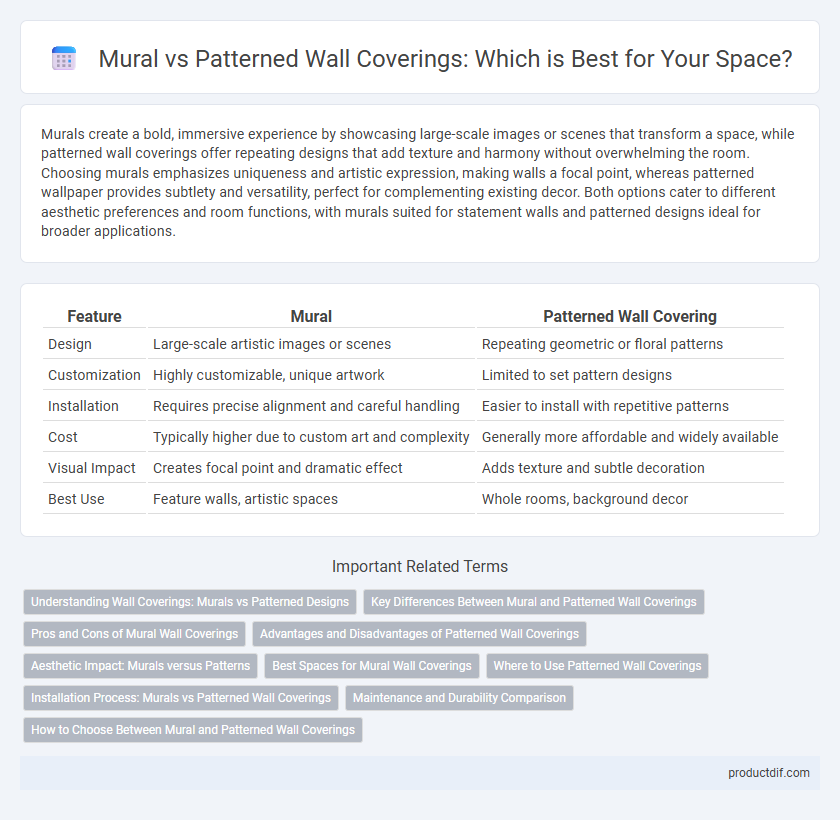Murals create a bold, immersive experience by showcasing large-scale images or scenes that transform a space, while patterned wall coverings offer repeating designs that add texture and harmony without overwhelming the room. Choosing murals emphasizes uniqueness and artistic expression, making walls a focal point, whereas patterned wallpaper provides subtlety and versatility, perfect for complementing existing decor. Both options cater to different aesthetic preferences and room functions, with murals suited for statement walls and patterned designs ideal for broader applications.
Table of Comparison
| Feature | Mural | Patterned Wall Covering |
|---|---|---|
| Design | Large-scale artistic images or scenes | Repeating geometric or floral patterns |
| Customization | Highly customizable, unique artwork | Limited to set pattern designs |
| Installation | Requires precise alignment and careful handling | Easier to install with repetitive patterns |
| Cost | Typically higher due to custom art and complexity | Generally more affordable and widely available |
| Visual Impact | Creates focal point and dramatic effect | Adds texture and subtle decoration |
| Best Use | Feature walls, artistic spaces | Whole rooms, background decor |
Understanding Wall Coverings: Murals vs Patterned Designs
Murals create immersive, large-scale visuals that transform entire walls into artistic statements, often customized with intricate images or landscapes. Patterned designs feature repetitive motifs or geometric shapes, adding texture and rhythm to spaces without dominating the room's ambiance. Choosing between murals and patterned wall coverings depends on the desired impact, with murals offering bold focal points and patterns providing subtle, versatile decor.
Key Differences Between Mural and Patterned Wall Coverings
Mural wall coverings feature large-scale, continuous images or scenes that create immersive visual experiences, often customized or photographic in nature. Patterned wall coverings consist of repeating designs or motifs, such as geometric shapes, florals, or textures, providing rhythm and structure to a space. Key differences include murals offering unique, narrative-driven aesthetics, while patterned coverings emphasize consistency and seamless repetition for a cohesive look.
Pros and Cons of Mural Wall Coverings
Mural wall coverings create a striking focal point with customizable artwork that enhances spatial aesthetics and personal expression but may require professional installation and higher costs compared to patterned designs. Unlike patterned wall coverings that offer repetitive motifs for easy matching and seamless coverage, murals demand precise alignment and can be less versatile for future room changes. The unique, large-scale imagery of murals elevates interior design but limits flexibility and may show wear more noticeably over time.
Advantages and Disadvantages of Patterned Wall Coverings
Patterned wall coverings offer versatility and visual interest by incorporating repetitive designs that can enhance room texture and depth. Their advantages include easy coordination with various decor styles and the ability to mask minor wall imperfections, though they may overwhelm small spaces or complicate pattern matching during installation. Disadvantages involve potential fading over time due to sunlight exposure and limited customization compared to murals, which provide large-scale, unique imagery.
Aesthetic Impact: Murals versus Patterns
Murals create a bold, immersive environment by transforming entire walls with large-scale art that commands attention and evokes emotion, making them ideal for statement spaces. Patterned wall coverings offer a repetitive, rhythmic visual that adds texture and depth without overwhelming the room, creating harmony and subtle elegance. Choosing between murals and patterned designs depends on the desired atmosphere--dramatic and expressive or balanced and refined.
Best Spaces for Mural Wall Coverings
Mural wall coverings are ideal for large, open spaces such as living rooms, entryways, and commercial lobbies where their expansive designs create striking focal points and enhance visual depth. They work exceptionally well on feature walls, turning plain surfaces into dramatic art installations that elevate the room's atmosphere. Unlike patterned wall coverings, murals offer unique customization options that align with specific themes or branding, making them perfect for galleries, offices, and hospitality environments seeking a bold design statement.
Where to Use Patterned Wall Coverings
Patterned wall coverings are ideal for accent walls in living rooms, bedrooms, and dining areas, adding texture and visual interest without overwhelming the space. Their versatility makes them suitable for both residential and commercial interiors, enhancing ambiance while complementing existing decor. Patterned designs work well in smaller spaces where a full mural might be too bold or distracting.
Installation Process: Murals vs Patterned Wall Coverings
Murals require precise alignment of large, often single-piece panels to create a seamless image, making professional installation essential to avoid misalignment. Patterned wall coverings involve repetitive designs that allow for some margin of error, as installers can match borders and adjust strips more easily. The complexity of mural installation increases labor time and cost compared to patterned wall coverings, where straightforward pattern matching simplifies the process.
Maintenance and Durability Comparison
Murals typically require more delicate maintenance due to their detailed artwork and potential for color fading, while patterned wallpapers often use durable vinyl materials that resist stains and wear more effectively. Wall murals may need specialized cleaning methods to preserve image quality, whereas patterned designs can generally be cleaned with mild soap and water. Durability favors patterned wall coverings in high-traffic areas, making them a practical choice for long-term use.
How to Choose Between Mural and Patterned Wall Coverings
Choosing between mural and patterned wall coverings depends on the desired visual impact and room size; murals typically create a bold, immersive atmosphere suited for feature walls, while patterned coverings offer repetitive designs that add texture and depth without overwhelming the space. Consider the scale and theme of your room, as murals often serve as focal points and require larger walls, whereas patterned wallpapers work well in smaller areas or entire rooms to maintain continuity. Material durability and ease of installation also influence the decision, with vinyl wallpapers favored for high-traffic areas and murals available in various print qualities tailored to artistic preferences.
Mural vs Patterned Infographic

 productdif.com
productdif.com